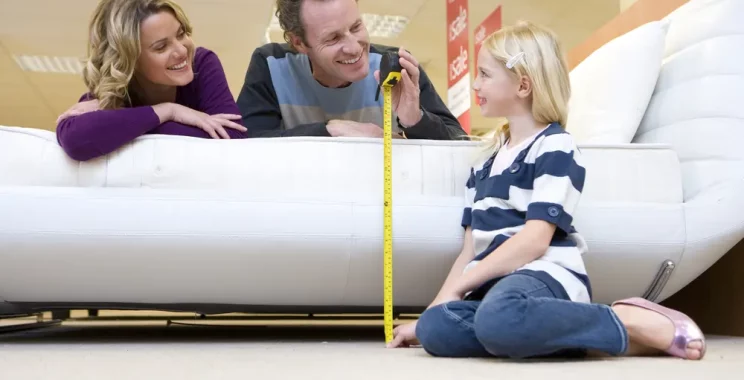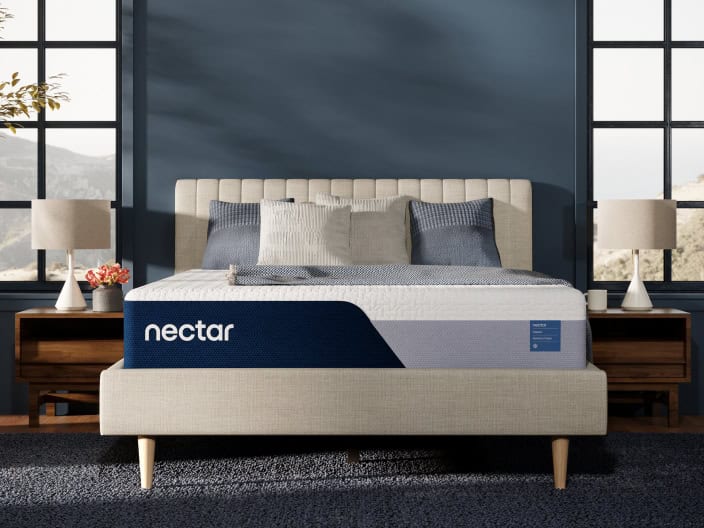What is Ideal Bed Height?
Share
Fact checked
Reviewed by experts
Updated
January 10, 2023
Quick read
5 mins to read
List of Content
When redecorating a room, there are so many things to consider, the wallpaper, the arrangement, the bed, the mattress, pillows, sheets, and most importantly, the bed height. The last one is often overlooked and forgotten, only to find yourself uncomfortable climbing or getting out of the bed.
Choosing the perfect bed height can impact your comfort while in and out of your bed. It also makes your bed comfortable or uncomfortable until you get it fixed. If you want a perfect bed height, read on to know the standard bed height from the floor and how much gap you should keep.
What Is the Ideal Bed Height?
The ideal height of the bed from the floor is approximately 25 inches; this is considered the standard bed height. You can measure your bed height with a measuring tape to be sure. Anything higher and lower than the normal bed height would be uncomfortable.
Another way to measure the height of your bed is to sit on your bed simply. If you feel your legs are too high, you know your bed is higher than the usual height. If your knees do not make a 90-degree angle when you sit, your bed height is too low.
There are other factors that you should consider before setting your bed, like sleeping preference, physical feasibility, etc. Hence, you should be a bit more considerate about these things too.
How to Choose the Best Bed Height
When choosing a new bed, there are a few factors to consider to make your bed comfortable. The most important factor is to find your personal preference, and the others are listed below. No matter your preference, these factors fall under the must-consider category. Take a look at these before you freeze a bed height.
Your height
When deciding the height of a bed, the first thing you should consider is your height. As it majorly depends on your and your partner’s height because you two will be the ones using the bed frequently.
Shorter people would want to have a comfortable height so that they can get out of it easily. Taller people, on the other hand, would opt for something higher. Taller people can adjust a lower bed by adding a box spring.
Age
You might also want to consider your current age. If you are a youngster, then having a high or low bed is out of the question. You might give smaller children a lower bed as they cannot climb up regularly or might even fall off their beds sometimes. Elderly people need a bed that isn’t too high or low, so for them, the bed height can be customized accordingly for easy mobility.
Mattress
The thickness of the mattress plays an important role in deciding the height of the bed. Mattresses can range in thickness from 8 – 14 inches, depending on the type of mattress you should measure. If your mattress is 14-15 inches tall, then you’ll need a mattress that is a maximum of 11 inches tall, not more than that if you are going for the normal bed height of 25 inches.
Your sleeping partner
It is unlikely that you and your partner are going to be of the same height. For this reason, you both should decide what height will be comfortable for the two of you. When determining a standard bed height, you should consider both your needs beforehand and then freeze a number. You can also adapt to each other’s needs by adjusting to the surroundings. For example, if one is tall and the other is short, you can add a set stool next to the bed.
Room size
The size of the room also plays an important role in choosing a bed. Make sure you have space for a bed you desire, and the room’s height doesn’t become an issue. You should also consider whether a box spring adjusts well within the room or not. A tip would be to keep the size of the room in mind before purchasing a bed and its required accessories.
Type of bed
The type of bed and bed frames are equally important when choosing a mattress. There are many beds available at different heights. If you have a low-profile bed frame, you can choose a mattress with 14 inches of depth. For high beds, the bed frame height should be below 11 inches.
Types of Bed Frames
Apart from the factors as mentioned earlier, types of bed frames are the ones that will decide how much space you will get to increase the height of your bed. The bed industry has many bed frames at different heights; this widens the possibility of finding a bed with perfect height.
Let’s explore the major types of bed frames.
Platform Beds
These beds can support the bed frames on their own. Platform bed height isn’t high as they are typically low to the ground. These beds have good slatted support and hence do not require a box spring for extra layering. The slates come in stripes or covered form to support the mattress. Since these beds are closer to the ground, you can have a thick mattress to increase the height of the bed.
Adjustable Bed
Adjustable bed frames come in different sizes and heights, and as the name suggests, they are great at adjusting bed heights. These beds are great for people who have different needs during the night. Mostly these frames are used for bedridden people or someone who has serious physical injuries.
It offers different positions with height adjustable bed frame features to make sure you are comfortable. These different positions adjust according to your needs, so adding an extra layer for height is really not necessary.
Traditional Bed
Traditional beds are for those who prefer tall beds. It comes in different sizes, options, and styles. Most traditional beds come with metal or wood support for a foundation. These bed frames require a box spring or a platform to support the mattress and add height to the bed. Some beds come with slates thereby, reducing the need for a box spring.
The main point here is, these beds have a great height, and mostly, you won’t need an additional layer to increase the bed height.
Upholstered Beds
Upholstery beds have tall bed frames, and those are usually covered in fabric. In some cases, the whole frame might be covered or just the headframe. Most upholstery beds are closer to the ground, but you can add an extra support layer to standardize the bed height. As these beds are not easy to move, it would be great to adjust the height beforehand if you do not wish to add a box spring.
Usually, adding a boxspring would be the best option. You could add that anytime, and it won’t create any trouble moving the bed.
Summing It up
In the end, it is all about finding the balancing height of the bed. Now that you know 25 inches is the standard height of the bed, adjusting yours to it won’t be an issue. Such that it doesn’t make getting in and out of the bed an issue.
The best way to consider the bed height would be the one that doesn’t affect your comfort. Moreover, one should also consider physical issues related to the person while deciding the bed height.
FAQs
No. Bed height does not affect your comfort while sleeping. A bed height can make it difficult for you to get in and out of bed but not the comfort. The comfort of the bed depends on the mattress’s firmness. If that is not up to your requirements, it can lead to discomfort.
The average bed height should be around 25 inches minded that you are young and do not have any physical issues. The ideal bed height for the elderly should be around 20-23 inches, as with age, mobility can become an issue.
A low-profile bed frame is one that sits close to the ground. These beds are only 5 inches high. Hence these types of beds are great for small children who can get in and out easily.
This website does not offer medical advice nor professional medical services; rather, it is provided solely for educational, informational, and/or entertainment purposes. Individuals seeking medical advice should consult a licensed physician. The information provided should not be used for diagnosis or treatment of any condition, disease, or injury. When you have a medical condition, you should always talk to licensed doctor or other certified medical professional. You should never delay seeking professional medical advice or treatment based on the contents of this website. Call 911 or immediately go to the nearest emergency room if you think you may have a medical emergency. The contents of this website are provided “as-is”, Sleep Authority and its parent, subsidiaries, affiliates, employees, contributors disclaim any warranty of the information contained herein. Please contact using contact form to report any errors, omissions, misinformation, or abuse.
Sleep Authority is brought to you by Resident, the company that brings you Nectar, DreamCloud, Awara, Wovenly, Bundle, Home Well Designed and Level Sleep.





